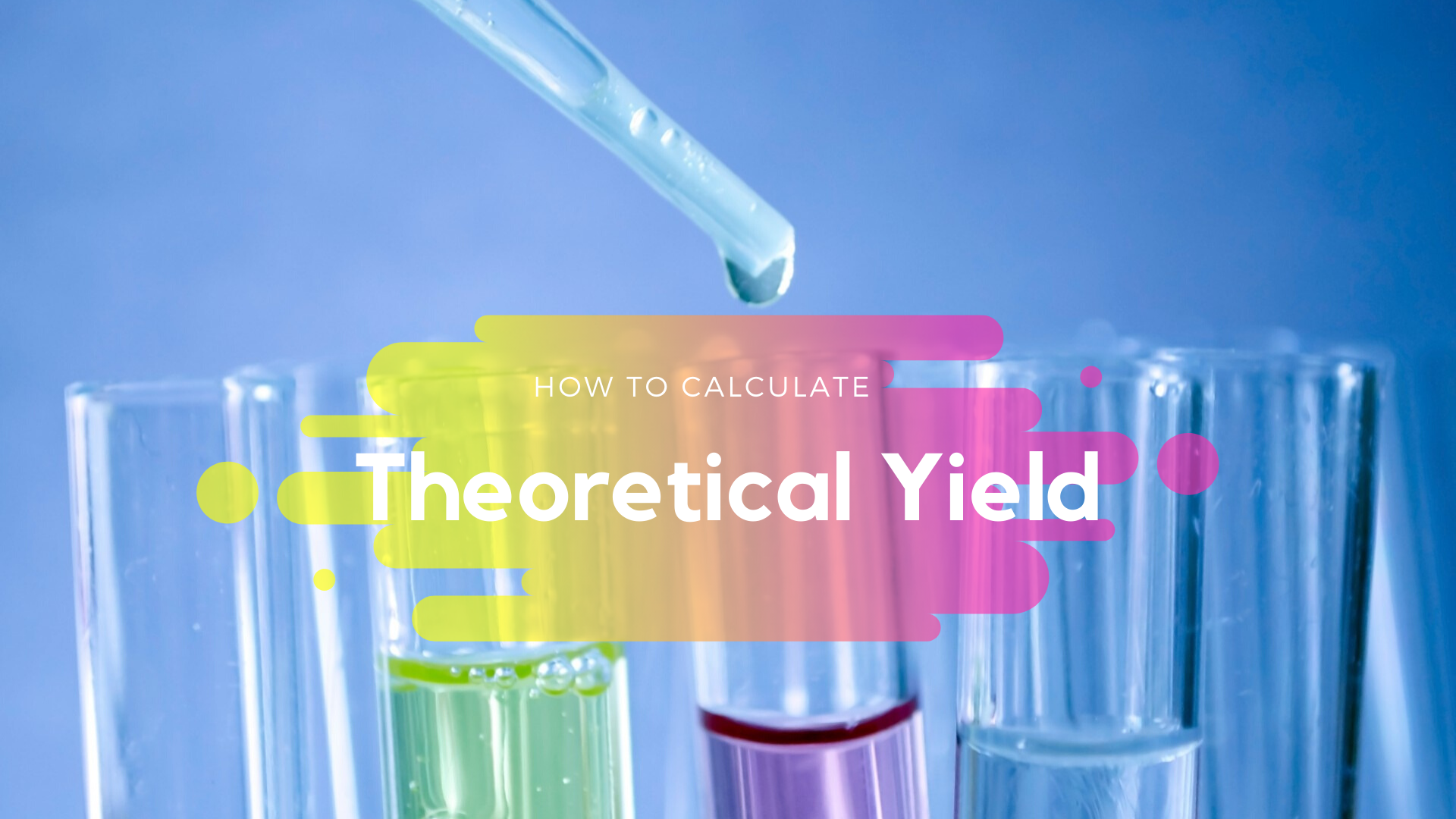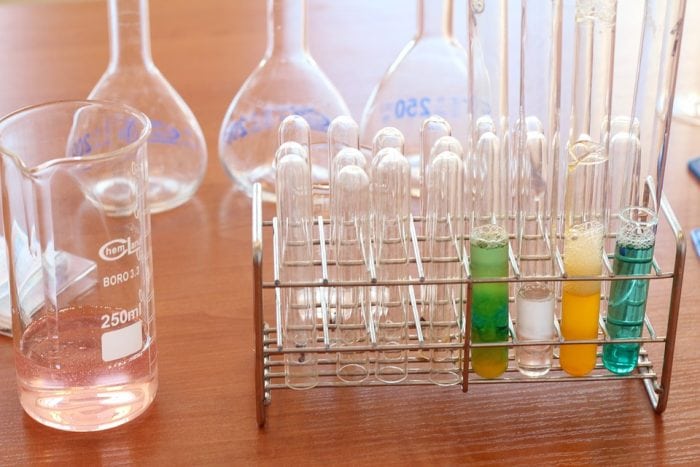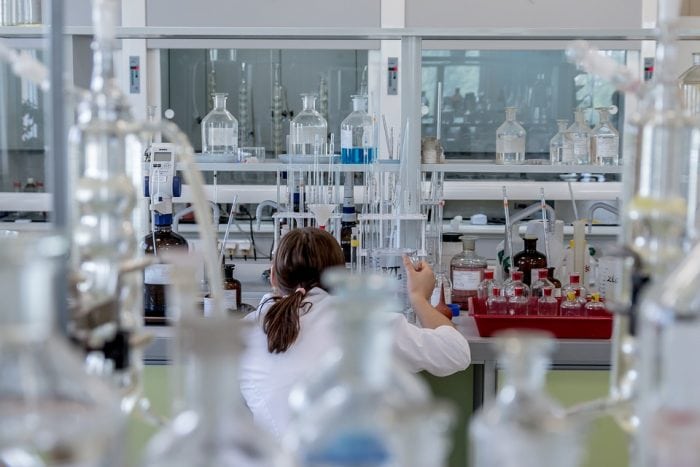
In chemistry, theoretical yield is a term that describes the amount of product that would result from a chemical reaction, assuming that chemical reaction completes. A chemical reaction is only considered complete when the entire limiting reactant is used up and it is impossible to create more products from the remaining chemicals.
Theoretical yield is estimated/calculated based on the number of moles of the reactants. In order to determine a theoretical yield, you must first know the reaction equation and determine how many moles of each reactant you being the reaction with.
Defining Terms
- Theoretical yield – The max amount of product a reaction will produce through a complete chemical reaction, based upon the amount of limiting reagent/limiting reactant.
- Limiting reactant/limiting reagent – The reactant that determines how much of a product can be made due to its limited amount.
Theoretical Yield – Moles And Grams
To start with, you’ll need to determine how much reactant you have. Note that the number of reactants you have may be different from the amount in your balanced equation. Afterward, determine the limiting reactant.
“Every chemical reaction has a transition state.” — Derek Barton
Start by using a periodic table to find the atomic weights of the elements that make up the molecules of your reactants. Find this by finding the weight of all the atoms in a single molecule. Now examine your balanced equation and find how the ratio between the reactants is defined. If one mole of a specific reactant results in two moles of a product, the ratio of reactant to the product is 1:2.

Theoretical yield is the amount of product that will be produced by the completed conversion of limiting reactant during a chemical reaction. Photo: bdyczewski via Pixabay, CC0
Now that you have the ratio between reactant and produced product defined, examine how much reactant and product you actually have. If the amount of actual reactant is precisely the same as what was defined in the balanced chemical equation, then the theoretical yield of your reactants is just the amount of product that your equation had determined. You can easily convert the number to grams by multiplying the molecular weight of the product with the number of moles.
You need to convert the amount of every product and every reactant into moles if you were given the amount in grams instead of moles. To determine how many moles of a reactant/product you have, you’ll need to divide the number of grams of said reactant/product by the molar mass for each molecule you previously calculated.
Now you have to identify the limiting reactant. Examine the ratios of reactants that you created earlier and compare the ratios with the number of reactants you genuinely have. The reactant that you have the least amount of (in relation to the amount needed to produce a certain volume of product) is your limiting reactant.
“Modern chemistry, with its far-reaching generalizations and hypotheses, is a fine example of how far the human mind can go in exploring the unknown beyond the limits of human senses.” — Horace G. Deming
Finally, to determine theoretical yield – how much of a product can be made with the amount of limiting reactant factored in – return to the ratios you created and a few steps ago. As an example, if you’ve created a balanced chemical equation that states you need 2 moles of your limiting reactant to produce 3 moles of product, but you only have 1 mole of it, you can only make around 1.5 moles of product. You can convert your theoretical yield in moles into grams rather easily, just multiply how many moles you have by the molar mass you determined earlier.
That’s a general explanation of determining theoretical yield. Let’s take a look at a specific example of determining theoretical yield from given moles and grams of specific elements.
Example:

Photo: jarmoluk via Pixabay, CC0
To start, you need to balance the chemical equation. For example: the equation H + O = H2O. To balance this equation, the hydrogen on the left half needs to become 2H and the H2O on the right must become 2 H2O. So the balanced version of this equation is: 2H + O –> 2H2O
The limiting agent needs to be identified now. The limiting reagent in a chemical reaction is the agent that you’ll use up first, limiting any further potential product. In the example with hydrogen and oxygen, if you had 5 moles of hydrogen and 3 moles of oxygen, hydrogen would be the limiting agent. This is because, as seen when you balanced the equation, you require a 2 to 1 ratio of hydrogen and oxygen. You would need 6 moles of hydrogen to use 3 moles of oxygen, but since there are only 5 moles of hydrogen it is the limiting agent.
Once the limiting agent has been determined, you can calculate the expected resulting moles of the product, based upon the number of moles of the limiting agent. This is done simply by multiplying the moles of a limiting agent by the ratio of product to the limiting agent. Returning once more to the H2O example, the ratio of water to hydrogen is 1 to 2. This means that 0.5 x 5 moles H = 2.5 moles of water (H2O).
“We are going from reading our genetic code to the ability to write it. That gives us the hypothetical ability to do things never contemplated before.” — Craig Venter
In Summary:
- Begin by determining the number of moles you have for every reactant. If you have a gas or liquid, multiply the given volume by the given density and then divide all of that by molecular weight. For solids just divide the reactant’s mass by molecular weight.
- Next, create a balanced equation. Just take the molecular weight and multiply it by the number of moles, as determined in the equation. The reactant that possesses the smallest number of moles is what limits your reaction.
- You can now calculate the theoretical yield of the moles. Use the chemical equation to accomplish this. Just multiply the ratio of both the product and the limiting reactant with the number of moles of limiting reactant you have. (ex. If 4AI + 3O2 = 2 AI2O3 , limiting reactant is AI. Divide number of AI moles by two, since it takes four to make 2 AI2O3.)
- Finally, to get a theoretical yield, you’ll need to multiply the number of moles of the product by the molecular weight of the product. (Ex. 0.5 moles of AI2O3 multiplied by the molecular weight of AI2O3 is approximately 101.96 grams per mole. This means that the theoretical yield is 50.98 grams.)








